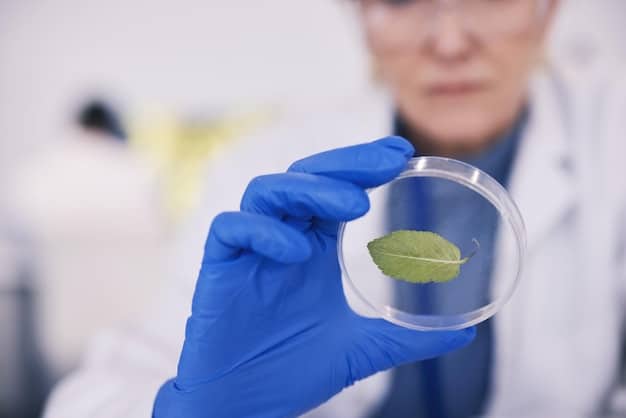Latest Innovations in Agricultural Biotechnology: Disease-Resistant Crops

Latest innovations in agricultural biotechnology are revolutionizing farming through disease-resistant crops, enhanced yields, and sustainable practices, addressing food security and environmental challenges.
The agricultural sector is undergoing a significant transformation driven by advancements in biotechnology. Among these, the latest innovations in agricultural biotechnology: disease-resistant crops and beyond, stand out as crucial for ensuring food security and promoting sustainable farming practices. This article delves into these cutting-edge developments and their implications for the future of agriculture.
Disease-resistant crops: a game changer
Disease-resistant crops represent a monumental leap forward in agricultural biotechnology. Traditional farming methods often rely heavily on pesticides, which can have detrimental effects on the environment and human health. Genetically engineered crops offer a sustainable alternative by naturally resisting diseases, reducing the need for harmful chemicals.
Benefits of disease-resistant crops
The adoption of disease-resistant crops has several profound benefits. These crops not only minimize environmental impact but also enhance crop yields and reduce economic losses for farmers.
- Reduced pesticide use: Decreased reliance on chemical pesticides translates to healthier ecosystems and safer food.
- Enhanced crop yield: Resistant crops experience fewer losses due to disease, leading to higher overall yields.
- Economic benefits for farmers: Lower input costs and higher yields contribute to increased profitability for farmers.
Furthermore, disease-resistant crops play a vital role in ensuring food security by stabilizing crop production in regions prone to disease outbreaks. This stability is crucial for feeding a growing global population.

Genetic engineering and CRISPR technology
Genetic engineering and CRISPR (Clustered Regularly Interspaced Short Palindromic Repeats) technology are at the forefront of creating disease-resistant crops. These advanced techniques allow scientists to precisely modify the genetic makeup of plants, enhancing their natural defenses against diseases.
Genetic engineering involves inserting specific genes into a plant’s genome to confer resistance to certain diseases. CRISPR, on the other hand, is a revolutionary gene-editing tool that allows for more precise and efficient modifications.
How CRISPR works
CRISPR works by using a guide RNA molecule to target a specific DNA sequence within a plant’s genome. Once the target sequence is identified, the CRISPR-associated protein 9 (Cas9) acts as molecular scissors, cutting the DNA at that precise location. This allows scientists to remove, add, or alter specific genes, resulting in disease-resistant traits.
The development of CRISPR technology has significantly accelerated the creation of disease-resistant crops, offering a more targeted and efficient approach compared to traditional genetic engineering methods.
Enhancing nutritional content through biotechnology
Beyond disease resistance, agricultural biotechnology is playing a crucial role in enhancing the nutritional content of crops. Biofortification, the process of increasing the nutritional value of crops, is being achieved through genetic engineering and other biotechnology techniques.
Biofortified crops can address micronutrient deficiencies in populations that rely heavily on staple foods. This approach is particularly important in regions where access to diverse and nutritious diets is limited.

Examples of biofortified crops
Several biofortified crops have already made a significant impact on global health. These include Golden Rice, which is enriched with beta-carotene, and iron-biofortified beans. These crops offer a sustainable and cost-effective way to combat malnutrition.
- Golden Rice: Genetically engineered to produce beta-carotene, a precursor to vitamin A, addressing vitamin A deficiency in populations that rely heavily on rice.
- Iron-biofortified beans: Designed to increase iron content, helping to combat iron deficiency anemia, a common health problem worldwide.
- Zinc-biofortified wheat: Developed to enhance zinc levels, essential for immune function and overall health.
By enhancing the nutritional content of staple crops, biotechnology is contributing to improved health outcomes and reduced healthcare costs.
Sustainable farming practices and biotechnology
Agricultural biotechnology is also promoting sustainable farming practices by reducing the environmental impact of agriculture. Genetically engineered crops can require fewer inputs, such as water and fertilizers, leading to more sustainable and eco-friendly agricultural systems.
These sustainable practices are essential for preserving natural resources and mitigating the effects of climate change.
Water-efficient crops
Drought-resistant crops are being developed through biotechnology to thrive in water-scarce regions. These crops can withstand prolonged periods of drought, ensuring stable food production even in challenging environmental conditions.
By reducing the need for irrigation, water-efficient crops help conserve precious water resources and promote sustainable water management.
Challenges and regulatory considerations
Despite the numerous benefits of agricultural biotechnology, there are also challenges and regulatory considerations that need to be addressed. Public perception and regulatory frameworks play a crucial role in the adoption and acceptance of genetically engineered crops.
Addressing these challenges is essential for realizing the full potential of agricultural biotechnology in a responsible and sustainable manner.
Public perception and acceptance
Public perception of genetically engineered crops varies widely, with some consumers expressing concerns about safety and environmental impact. Clear communication and transparency are essential for building trust and promoting informed decision-making.
Regulatory bodies, such as the U.S. Food and Drug Administration (FDA) and the Environmental Protection Agency (EPA), play a crucial role in ensuring the safety of genetically engineered crops. These agencies conduct rigorous assessments to evaluate potential risks and benefits before approving new crops for commercial use.
The future of agricultural biotechnology
The future of agricultural biotechnology holds immense promise for addressing global challenges related to food security, nutrition, and sustainable agriculture. Continued innovation and responsible regulation will be key to unlocking the full potential of these technologies.
Advancements in areas such as gene editing, synthetic biology, and precision agriculture are expected to further revolutionize crop production and improve agricultural practices.
| Key Point | Brief Description |
|---|---|
| 🌱 Disease-Resistant Crops | Reduced pesticide use and higher crop yields. |
| 🧬 CRISPR Technology | Precise gene editing for disease resistance. |
| 🌾 Biofortified Crops | Enhanced nutritional content of staple foods. |
| 💧 Water-Efficient Crops | Sustainable farming in water-scarce regions. |
Frequently Asked Questions
▼
Disease-resistant crops are plants that have been genetically modified or bred to withstand specific diseases, reducing the need for pesticides and enhancing crop yields.
▼
CRISPR technology uses a guide RNA to target a specific DNA sequence, allowing scientists to precisely edit genes and enhance disease resistance in crops.
▼
Biofortified crops are genetically modified to have increased levels of essential nutrients, such as vitamins and minerals, to combat malnutrition.
▼
Biotechnology promotes sustainable farming by reducing the need for pesticides, conserving water, and improving nutrient use efficiency.
▼
Regulatory bodies like the FDA and EPA rigorously assess the safety of genetically engineered crops before approving them for commercial use, ensuring they meet safety standards.
Conclusion
The latest innovations in agricultural biotechnology: disease-resistant crops and beyond, are transforming the agricultural landscape. From disease-resistant crops that reduce pesticide use to biofortified crops that enhance nutrition, these advancements hold the key to a more sustainable and food-secure future. By embracing these technologies responsibly, we can address global challenges and ensure a healthier planet for generations to come.





